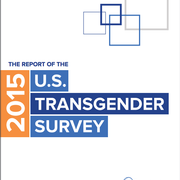Reflections On the 2015 U.S. Transgender Survey
By BA Laris, MPH | December 13, 2016
Research Associate, ETR | Personal pronouns: She, her, hers
As a researcher, I love data. I get excited about survey results that can help us shape ideas and norms in our community. I understand the power behind these numbers, that these numbers represent individuals and their life experience. Keeping things personal is also critically important to me as I review and integrate new research findings into my everyday life.
We were excited for the much-anticipated release of The National Center for Transgender Equality’s new 2015 U.S. Transgender Survey Report. This ambitious effort examines the experiences of almost 28,000 transgender people across the United States and its territories. It provides valuable data about the lives of transgender people and systematically validates the challenges they face every day.
It is also a deeply troubling report. The report acknowledges that “the findings reveal disturbing patterns of mistreatment and discrimination and startling disparities.…” A transgender acquaintance of mine found himself unable to finish reading the report because the statistics were so triggering.
Alarming Levels of Harm
The report describes alarming levels of harm occurring in a wide range of life arenas. These include being abused and victimized through both family and community-based violence, difficulty finding and keeping jobs, severe economic hardship, and harmful effects on both physical and mental health. Many survey respondents are avoiding health care services for fear of being mistreated.
The statistics are all there in the report. I hope you will review it. Rather than repeat them here, I’d like to suggest some positive steps we might take in response. Now that we have the data we can do some data-driven decision-making and take action. As professionals involved in health care, health education and training, I believe we have an obligation to be informed about the discrimination and disparities faced by all of the populations we serve. We must act in ways that minimize or eliminate the negative effects and promote our clients’ greatest possible well-being.
One Man’s Story
Here’s a story a friend told me that sums up some of the worst, and some of the best, behavior from a health care organization serving a family with transgender members.
My wife is a black transwoman. I am a white transman. We both have been walking through life as safely as possible. I currently am in between jobs and usually work as a delivery driver.
Recently, my wife was quite sick and had to go to the emergency room. When she was admitted, she was given a bracelet that said "male.” The admitting clerk had not asked or checked in with us about gender. I calmly showed the ID bracelet to him and asked him to change her documents to female. He answered, "Okay.” Then he didn't do anything about it.
Checking into the ER, our anxiety was heightened beyond just being sick. We were uncertain about how caregivers would react or give her care. When we got into the ER floor, the doctor asked my wife what pronouns she preferred and what she goes by. This small gesture went a long way.
Health care is one of the most important instances where providers can't just assume. It’s so important to respect everyone.
Positive Steps: What Can We Do?
The National Center for Transgender Equality has a great list of 52 Things You Can Do for Transgender Equality. Lots of great ideas there.
I’ve got a shorter list for people working in the areas of health education, delivery and training. This isn’t comprehensive. These are just a few ideas that occurred to me as I looked over the report and thought about my friend’s experience. I hope you’ll add some ideas of your own in the comments.
- Learn more about the language of gender and how to ask people about their personal gender pronouns.
- Work to create bias-free language in educational materials and trainings.
- In trainings or curricula, include examples of transgender, non-binary and cisgender people in case studies, roleplays, videos and vignettes.
- Create a visible welcome for transgender people and their families in your organizations—a poster, a transgender flag, gender neutral bathrooms (or a policy that allows people to choose the restroom that works best for them).
- Provide trainings for staff that help them develop skills to create a welcoming environment and provide non-discriminatory care for people of all genders.
One of the heartening findings in the Transgender Survey is that despite the hardships faced by transgender people, we are also seeing greater visibility and acceptance in society and families. More than half of publicly identified transgender students report being supported by classmates. More than two-thirds of transgender people who are out in their workplaces report being supported by their co-workers.
The work of transgender people and their allies is making a difference. Every one of us, whatever our gender identity, can join in that effort.
BA Laris, MPH, is a Research Associate with ETR. She plans, develops and coordinates evaluation activities in a variety of settings and also provides capacity-building assistance to community-based organizations working in HIV prevention across the United States. She can be reached at bal@etr.org.





